Add this eBook to your basket to receive access to all 237 records. Our indexes include entries for the spelling foss. In the period you have requested, we have the following 237 records (displaying 211 to 220): These sample scans are from the original record. You will get scans of the full pages or articles where the surname you searched for has been found. Your web browser may prevent the sample windows from opening; in this case please change your browser settings to allow pop-up windows from this site. Members of Cambridge University
(1935)
The Cambridge University Calendar for 1935-1936 includes this list of all living members of the university, i. e. not only undergraduates and members of staff, but also all surviving graduates from earlier generations. The names are arranged alphabetically by surname, then by college in order of foundation, and under the particular colleges by order of seniority of the B. A. degree. Surnames are given, initials, name of college, and then the years of graduating B. A. and M. A. Where a change of name had occurred since matriculation, the original name is inserted in brackets. For undergraduates the term of matriculation is given in square brackets with an M for Michaelmas, L for Lent or E for Easter. An asterisk before a surname indicates a member of the Senate. Names which appeared on the roll of the Regent House promulgated in November 1934 are marked with a dagger. Further degrees, such as PHD, MB, BCHIR, MD, &c. are listed in smaller capitals with the year conferred. | Sample scan, click to enlarge
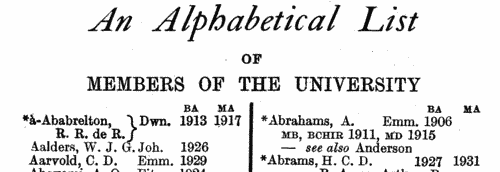
| Imperial Service Medal
(1936)
Awards by kings George V and Edward VIII of the Imperial Service Medal to officers of the Home Civil Service. The names are arranged alphabetically by surname (in capitals) and christian names, with office or rank in the service. | Sample scan, click to enlarge
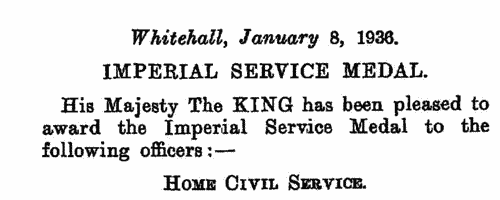
| Freemasons in Marama chapter, Palmerston North, New Zealand
(1938)
List of members of the Ancient and Accepted Rite for England, Wales, the Dominions and Dependencies of the British Crown, January 1938. An asterisk before a name indicates a P. M. W. S. of the Chapter; the number 30 indicates a Grand Elected Knight, K. H., 30th Degree; 31, Grand Inspector Inquisitor Commander, 31st Degree; 32, Sublime Prince of the Royal Secret, 32nd Degree. | Sample scan, click to enlarge
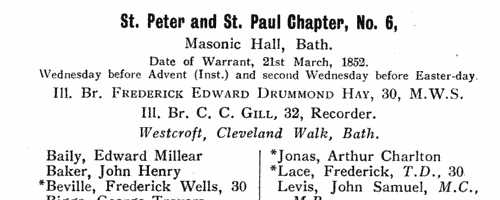
| Freemasons in Monckton chapter, Levin, New Zealand
(1938)
List of members of the Ancient and Accepted Rite for England, Wales, the Dominions and Dependencies of the British Crown, January 1938. An asterisk before a name indicates a P. M. W. S. of the Chapter; the number 30 indicates a Grand Elected Knight, K. H., 30th Degree; 31, Grand Inspector Inquisitor Commander, 31st Degree; 32, Sublime Prince of the Royal Secret, 32nd Degree. | Sample scan, click to enlarge
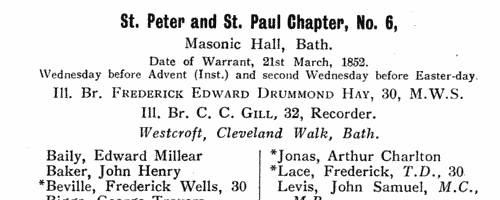
| Freemasons in Wellington chapter, New Zealand
(1938)
List of members of the Ancient and Accepted Rite for England, Wales, the Dominions and Dependencies of the British Crown, January 1938. An asterisk before a name indicates a P. M. W. S. of the Chapter; the number 30 indicates a Grand Elected Knight, K. H., 30th Degree; 31, Grand Inspector Inquisitor Commander, 31st Degree; 32, Sublime Prince of the Royal Secret, 32nd Degree. | Sample scan, click to enlarge
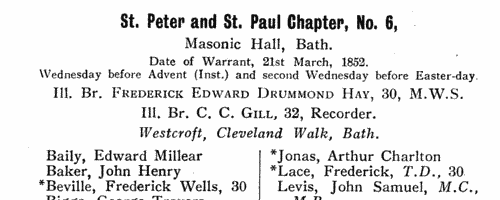
| Graduate Electrical Engineers (Graduate I. E. E.)
(1939)
The Institution of Electrical Engineers was founded in 1871 under the name of The Society of Telegraph Engineers, and incorporated by royal charter in 1921. The list of members, corrected to 1 September 1939, gives the names and addresses of the various grades of members. Members (M. I. E. E.) and Associate Members (A. M. I. E. E.) were entitled to describe themselves as Chartered Electrical Engineers. Then there are the Associates (Associate I. E. E.), Companions (Companion I. E. E.), Graduates (Graduate I. E. E.) and Students (Student I. E. E.). The names are given in bold, surname first; before each name is the year of attaining that grade; and for the higher grades the year of each lower grade is also given, e. g. (G. 1931). | Sample scan, click to enlarge

| Naval Officers
(1939)
The alphabetical list of officers on the Active List of the Royal Navy and Royal Marines (RM) gives: where serving; name (surname and initials); rank; and the dates of their seniority. This is the list from the March 1939 edition of the Navy List, corrected to 18 February 1939. | Sample scan, click to enlarge

| British Civil Servants
(1940)
The British Imperial Calendar lists civil servants in Britain, arranged according to the organizational structure of the state, and shows their qualifications and salaries. | Sample scan, click to enlarge
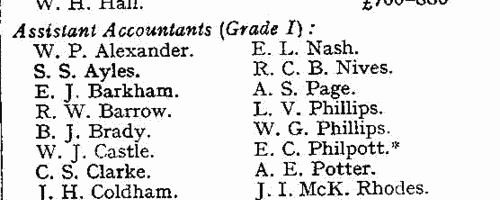
| Boys entering Aldenham School
(1942)
Aldenham School in Hertfordshire is a public school originating as an Elizabethan grammar school. The Aldenham School Register was first published in 1898, but this tenth edition, by R. J. Evans, and published in 1969, comprised only living old boys who had entered the school from 1900 onwards, together with those who had entered the school before 1900 and who had responded to a questionnaire. There is thus a general presumption that all the boys mentioned were alive in 1969. The boys are listed alphabetically by surname under the term in which they entered the school. Full name is given, in bold, surname first. Then an abbreviation indicating their house (B, Beevor's; K, Kennedy's; M, McGill's; P, Paull's; SH, School House); the period of stay at the school; address as of 1969; father's name, occupation and residence (where the father had also studied at the school, his name is given in capitals with the year of his entry); brief details of any achievements at the school (particularly at sports); and the briefest of details of subsequent career. | Sample scan, click to enlarge
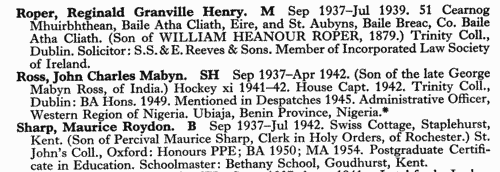
| Chemists
(1950)
The Royal Institute of Chemistry was founded in 1877, and was open only to British subjects (and also, in due course, to citizens of the newly-created Republic of Ireland). Associates of the institute (A. R. I. C.) qualified either by studying chemistry, physics, mathematics and an optional science for the institute's examination (which insisted on a high standard of practical laboratory efficiency); or by obtaining good honours degrees or equivalent qualifications, with chemistry as principal subject, and having undergone training in allied sciences. Associates of at least three years' standing could then be admitted to the Fellowship (F. R. I. C.) either by taking a further examination in a special branch of chemistry, or by submitting the results of work or evidence of experience sufficient to justify the Council in granting exemption from such further examination. This register of fellows and associates, correct to 31 August 1950, contains 11,545 names, arranged alphabetically, surname first (in capitals), with qualifications, current address, telephone number, and (in italics) a brief description of present post in the chemical industry. Finally, year of admission as associate (A.) (and, where appropriate, fellow (F.) is given on the right-hand side. With this may appear the notation (x) for a fellow of the Chemical Society, (y) for a member of the Society of Chemical Industry, or (z) for a joint subscriber to all three chartered bodies. | Sample scan, click to enlarge

|
Research your ancestry, family history, genealogy and one-name study by direct access to original records and archives indexed by surname.
|











